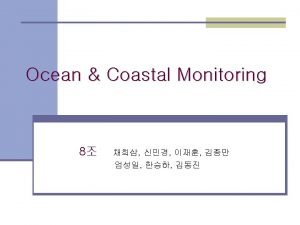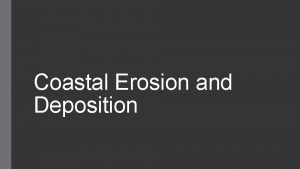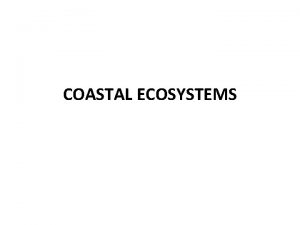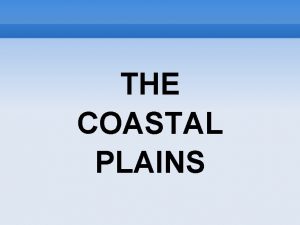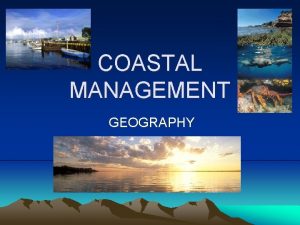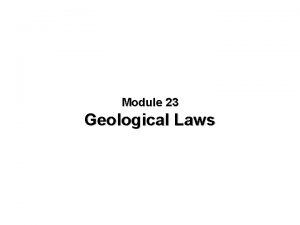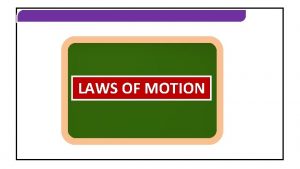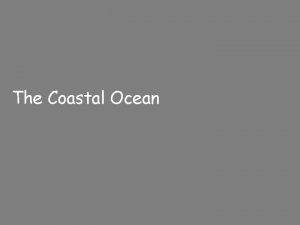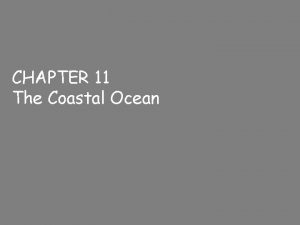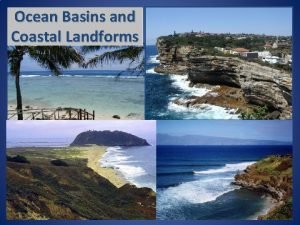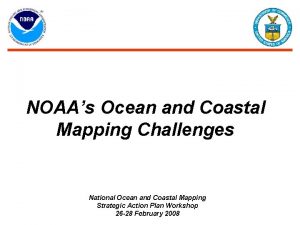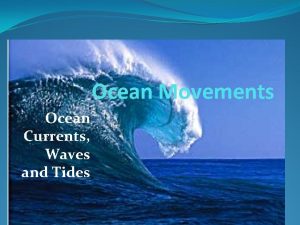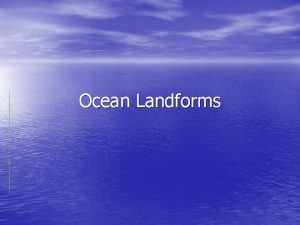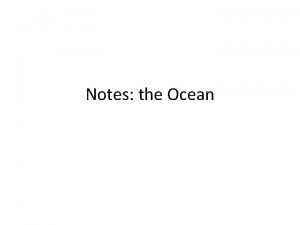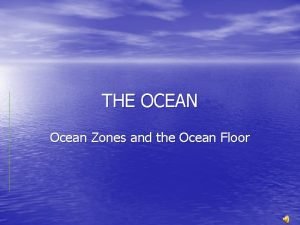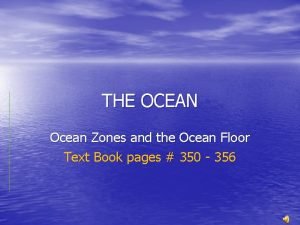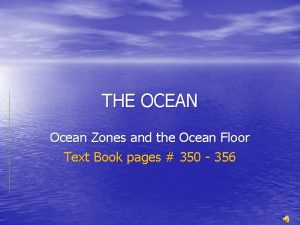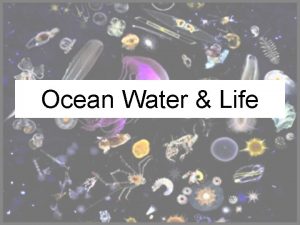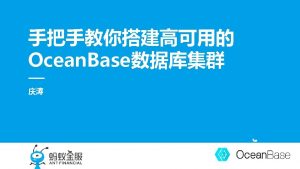The Coastal Ocean The Coastal Ocean I Laws



































- Slides: 35

The Coastal Ocean

The Coastal Ocean • I. Laws governing ocean ownership • A. Mare Liberum- 1609 – This law argued absolute freedom. On the premise the ocean was limitless. B. De dominio maris – 1702 Law providing for a Territorial Sea = area from shore a nation controlled = 3 nautical miles.

The Coastal Ocean C. United Nations Law of the Sea- Negotiations in 1958, 1960, 1973 – 1982, and 1993. The treaty includes. 1. Coastal Nations Jurisdiction – 12 mile territorial sea. a. Also a Exclusive Economic Zone (EEZ) – Includes minerals, fishing, pollution regulation. 200 nautical miles from shore.

The Coastal Ocean 2. Ship Passage – Right of free passage of all vessels preserved. 3. Deep-ocean Mineral Resources – UN controls private mining through International Seabed Authority (ISA). Contentious issue (i. e. Money). 4. Arbitrations of disputes – United Nations Law of the Sea Tribunal. 42% of worlds oceans under control of coastal nations.

The Coastal Ocean • II. Characteristics of Coastal waters. – A. Coastal waters = relatively shallow and directly influenced by processes on land. – B. Salinity – Salt water is more dense than fresh. • 1. Runnoff generally lowers salinity of coastal regions.

• 2. Halocline – fresh runoff water does not mix well with salt water = creates a “wedge” of fresh water off the shore, on top of the salt water. a. Prevailing offshore winds cause evaporation, thus creating higher concentration of salinity at surface = another halocline.

The Coastal Ocean • 2. Isohaline – in shallow waters tides force mixing of salt and fresh water.

The Coastal Ocean

The Coastal Ocean – C. Temperature – Different latitudes have different temp. mixing patterns. • 1. Isothermal - In very high and low latitudes temp is uniform. (Cold at high lat. And warm at low lat. ) • 2. Thermocline – at mid latitudes, changes in summer and winter temperatures in addition to offshore winds cause changes in temp according to depth (thermocline).

The Coastal Ocean

The Coastal Ocean • D. Coastal Geostrophic Currents – Circular ocean currents in coastal waters fueled by gravity. – 1. Wind pushes water causing it to “pile up” near shore. Gravity pulls it back out to sea. – 2. Coriolis effect causes it to curve (right in N. Hem. ) and left in S. Hem. )

The Coastal Ocean • 3. Do to fresh water halocline in N. hemisphere (Washington and Oregon) the Davidson Coastal Geostrophic Current is created (Fresh water moves N. up coast before mixing with open ocean).

The Coastal Ocean • III. Types of Coastal Waters – Estuaries, Coastal Wetlands, Lagoons and Marginal Seas. – A. Estuary – Partially enclosed coastal body of water in which salty ocean water is significantly diluted by fresh water from runoff. There are different types.

The Coastal Ocean 1. Types of estuaries a. Coastal Plain estuary- “drowned river valleys” caused by rising sea level. Eg. Chesapeake Bay.

The Coastal Ocean –b. Fjord – Flooded glacial valley. Ushaped. –c. Bar-build Estuary – Caused by sand deposits such as barrier islands which create lagoons that mix with river runoff. Common on E. coast and in the Gulf.

The Coastal Ocean • d. Tectonic Estuary – Caused by faults folding, creating a depression into which rivers flow. Eg. San Francisco Bay.

The Coastal Ocean

The Coastal Ocean • 2. Water mixing in Estuaries – Mixing varies. – a. Vertically mixed – Shallow small estuaries cause even mixing of water. Salinity is uniform becoming saltier moving from estuary head to mouth.

The Coastal Ocean • b. Slightly Stratified Estuary - Slightly deeper. Salinity increases from head to mouth, however, saltier near bottom, mixing in the mid -depths. Deep water moves from mouth to head. Shallow from head to mouth. Called Esutuary Circulation Pattern.

The Coastal Ocean • c. Highly Stratified Estuary- Deep Estuary. Upper layer increases in salinity from head to mouth. Deep water is uniform in salinity and moving from mouth to head. Strong haloclines.

The Coastal Ocean • d. Salt wedge estuary - Deep, high volume estuaries. Water fresh on top with salty wedge beneath.

The Coastal Ocean – 3. Estuaries and humans • a. Columbia River Estuary – Dykes, dams, clear-cutting, dredging and agriculture have affected this delicate ecosystem. • b. Chesapeake Bay Estuary – Largest estuary in US. – i. Formed by drowning of Susquehanna river. – ii. It is slightly stratified, facing drastic seasonal changes. – iii. Sewage (ie nutrients) causes lower-levels to become anoxic (no oxygen) killing many of the bottom dwellers.

The Coastal Ocean • B. Coastal Wetlands – High water-table. Often along estuaries. Include, marshes, swamps, tidal flats, and bayous. – 1. Salt Marshes and Mangrove Swamps = two most important coastal wetlands. • a. Intermittently submerged and have peat deposits supporting halophytic plants (salt loving) • b. Mangroves exist from 30 degrees latitude to the equator (0 degrees).


The Coastal Ocean – 2. Characteristics of coastal wetlands. • i. One of the most bioproductive biomes on earth • ii. Crucial nursery of aquatic life and waterfowl migration. • iii. Crucial for pollutant filtration. Remove nitrogen compounds, and metals which become trapped in clay mud. • iv. Absorb water from coastal flooding (eg. Tsunamis). • v. ½ of the nations wetlands have vanished due to development.

The Coastal Ocean C. Lagoons – Bar-built type estuary landward of barrier islands. (also an amusement park in SLC) 1. Three distinct zones a. Freshwater zone – near the head of the lagoon. b. Transitional zone – Brackish water near the middle of lagoon. c. Saltwater zone – near lagoon mouth.

The Coastal Ocean D. Marginal Seas – Caused by isolated pieces of low-lying ocean crust between continents. 1. Semi-isolated from the ocean with unique circulation patterns. 2. Different salinity and temp from general ocean. 3. Relatively shallow. 4. Examples – Caribbean, Mediterranean, Bay of Bengal, Arabian Sea…. Etc.

The Coastal Ocean – 5. Marginal seas of the Indian Ocean include The Red Sea, The Arabian Sea, and the Bay of Bengal. » The Arabian sea and Bay of Bengal are influenced by Monsoon circulation patterns. » Bay of Bengal also influenced by runoff from the Ganges river.

The Coastal Ocean

The Coastal Ocean • IV. Marine Pollution – What is it?

The Coastal Ocean – A. Definition by World Health Organization – “The introduction by man, directly or indirectly, of substances or energy into the marine environment, including estuaries, which results or is likely to result in such deleterious effects as harm to living resources and marine life, hazards to human health, hindrance to marine activities, including fishing and other legitimate uses of the sea, impairment of quality for use of sea water and reduction of amenities. ”

The Coastal Ocean – B. Standard laboratory Bioassay – Measurement used by environmental agencies • 1. Uses the Kill 50 measure – concentration of a pollutant that kills 50% of test organisms. • 2. Does not consider long-term or interactive effects.

The Coastal Ocean • Waste disposal in the ocean – Should we? – What should we do with our waste?

The Coastal Ocean • V. Types of Pollution. – Coastal waters are more polluted due to dumping from land sources and poor circulation.

 Ocean tides observed at coastal locations
Ocean tides observed at coastal locations Charles de secondat
Charles de secondat Ocean ocean convergent boundary
Ocean ocean convergent boundary Sciencechannel.com/activate
Sciencechannel.com/activate Convergent boundary
Convergent boundary Convergent oceanic oceanic plate boundary
Convergent oceanic oceanic plate boundary Ocean ocean convergent boundary
Ocean ocean convergent boundary Red ocean strategi
Red ocean strategi Continent continent convergent
Continent continent convergent Chapter 15 ocean water and ocean life wordwise answer key
Chapter 15 ocean water and ocean life wordwise answer key Hát kết hợp bộ gõ cơ thể
Hát kết hợp bộ gõ cơ thể đặc điểm cơ thể của người tối cổ
đặc điểm cơ thể của người tối cổ Cái miệng bé xinh thế chỉ nói điều hay thôi
Cái miệng bé xinh thế chỉ nói điều hay thôi Cách giải mật thư tọa độ
Cách giải mật thư tọa độ Tư thế worm breton là gì
Tư thế worm breton là gì ưu thế lai là gì
ưu thế lai là gì Tư thế ngồi viết
Tư thế ngồi viết Voi kéo gỗ như thế nào
Voi kéo gỗ như thế nào Thẻ vin
Thẻ vin Thể thơ truyền thống
Thể thơ truyền thống Các châu lục và đại dương trên thế giới
Các châu lục và đại dương trên thế giới Từ ngữ thể hiện lòng nhân hậu
Từ ngữ thể hiện lòng nhân hậu Diễn thế sinh thái là
Diễn thế sinh thái là Slidetodoc
Slidetodoc V. c c
V. c c Làm thế nào để 102-1=99
Làm thế nào để 102-1=99 Hát lên người ơi alleluia
Hát lên người ơi alleluia Sự nuôi và dạy con của hổ
Sự nuôi và dạy con của hổ Lời thề hippocrates
Lời thề hippocrates đại từ thay thế
đại từ thay thế Quá trình desamine hóa có thể tạo ra
Quá trình desamine hóa có thể tạo ra Vẽ hình chiếu vuông góc của vật thể sau
Vẽ hình chiếu vuông góc của vật thể sau Công thức tính độ biến thiên đông lượng
Công thức tính độ biến thiên đông lượng Thế nào là mạng điện lắp đặt kiểu nổi
Thế nào là mạng điện lắp đặt kiểu nổi Dot
Dot Bổ thể
Bổ thể




































